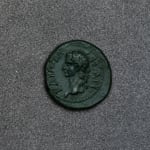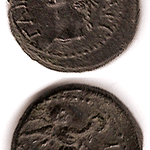Bronze Coin of Emperor Caligula and Thracian King Rhoemetalces III, 38 CE - 46 CE
Bronze
6.7g
LC.008
Further images
Obverse | Lateral portrait of Emperor Caligula wearing a laurel wreath Inscription | ΓΑΙΩ ΚΑΙΣΑΡΙ Reverse | Victoria, the goddess of victory with wings and a wreath Inscription | ΡΑΙΣΚΟΥΠΟΡΕΩΣ...
Obverse | Lateral portrait of Emperor Caligula wearing a laurel wreath
Inscription | ΓΑΙΩ ΚΑΙΣΑΡΙ
Reverse | Victoria, the goddess of victory with wings and a wreath
Inscription | ΡΑΙΣΚΟΥΠΟΡΕΩΣ
Condition: Dark patina, good-very fine, rare.
This is a bronze coin of the Roman Emperor Caligula and the Thracian King Rhoemetalces III, issued by the Thracian Kingdom, a vassal state of the Roman Empire. On the obverse of the coin is a side portrait of the Roman Emperor Caligula wearing a laurel wreath, with the title Gaius Caesar Augustus Germanicus written in Ancient Greek, "ΓΑΙΩ ΚΑΙΣΑΡΙ". The reverse shows an image of Victoria, the Roman mythological goddess of victory, with outstretched wings and a wreath, and the coat of arms reads "ΡΑΙΣΚΟΥΠΟΡΕΩΣ," presumably referring to Rhoemetalces III.
This issue was for many years attributed to Agrippa I (Meshorer 278, no. 2) until Burnett assigned it to Thrace and Rhoemetalces III (on the basis of style and die axis). Gaius Julius Caesar Germanicus was the youngest son of Germanicus and Agrippina Sr. He spent much of his childhood accompanying his father on military campaigns. It is here that he received his nickname, “Caligula,” or “Little Army Boots,” from the soldiers. Although his family underwent much persecution, the young Caligula was spared the same fate of his relatives and was instead named as successor to Emperor Tiberius. As Emperor, Caligula spend large sums of money honoring his deceased family, as much to restore his good name as to please the army, among whom Germanicus was still remembered fondly. A few years into his reign, however, it became clear that Caligula had intentions to reshape the principate into a full-fledged monarchy. Most of the scandalous events conservative historian detailed must be seen in this light. Caligula followed in the footsteps of Hellenistic and Egyptian rulers by posturing himself as a god, much to the horror of the Roman historians. In the end, Caligula would be overcome by those around him who plotted against him and, when threatened, eliminated the Emperor to save their own lives.
How many hands have touched a coin in your pocket or purse? What eras and lands have the coin traversed on its journey into our possession? As we reach into our pockets to pull out some change, we rarely hesitate to think of who might have touched the coin before us, or where the coin will venture to after it leaves our hands. More than money, coins are a symbol of the state that struck them, of a specific time and location, whether contemporary currencies or artifacts of a long forgotten empire. This stunning hand-struck coin reveals an expertise of craftsmanship and intricate sculptural detail that is often lacking in contemporary machine-made currencies. This ancient coin is a memorial to an emperor’s reign passed down from the hands of civilization to civilization, from generation to generation, which still appears as vibrant today as the day it was struck.
Inscription | ΓΑΙΩ ΚΑΙΣΑΡΙ
Reverse | Victoria, the goddess of victory with wings and a wreath
Inscription | ΡΑΙΣΚΟΥΠΟΡΕΩΣ
Condition: Dark patina, good-very fine, rare.
This is a bronze coin of the Roman Emperor Caligula and the Thracian King Rhoemetalces III, issued by the Thracian Kingdom, a vassal state of the Roman Empire. On the obverse of the coin is a side portrait of the Roman Emperor Caligula wearing a laurel wreath, with the title Gaius Caesar Augustus Germanicus written in Ancient Greek, "ΓΑΙΩ ΚΑΙΣΑΡΙ". The reverse shows an image of Victoria, the Roman mythological goddess of victory, with outstretched wings and a wreath, and the coat of arms reads "ΡΑΙΣΚΟΥΠΟΡΕΩΣ," presumably referring to Rhoemetalces III.
This issue was for many years attributed to Agrippa I (Meshorer 278, no. 2) until Burnett assigned it to Thrace and Rhoemetalces III (on the basis of style and die axis). Gaius Julius Caesar Germanicus was the youngest son of Germanicus and Agrippina Sr. He spent much of his childhood accompanying his father on military campaigns. It is here that he received his nickname, “Caligula,” or “Little Army Boots,” from the soldiers. Although his family underwent much persecution, the young Caligula was spared the same fate of his relatives and was instead named as successor to Emperor Tiberius. As Emperor, Caligula spend large sums of money honoring his deceased family, as much to restore his good name as to please the army, among whom Germanicus was still remembered fondly. A few years into his reign, however, it became clear that Caligula had intentions to reshape the principate into a full-fledged monarchy. Most of the scandalous events conservative historian detailed must be seen in this light. Caligula followed in the footsteps of Hellenistic and Egyptian rulers by posturing himself as a god, much to the horror of the Roman historians. In the end, Caligula would be overcome by those around him who plotted against him and, when threatened, eliminated the Emperor to save their own lives.
How many hands have touched a coin in your pocket or purse? What eras and lands have the coin traversed on its journey into our possession? As we reach into our pockets to pull out some change, we rarely hesitate to think of who might have touched the coin before us, or where the coin will venture to after it leaves our hands. More than money, coins are a symbol of the state that struck them, of a specific time and location, whether contemporary currencies or artifacts of a long forgotten empire. This stunning hand-struck coin reveals an expertise of craftsmanship and intricate sculptural detail that is often lacking in contemporary machine-made currencies. This ancient coin is a memorial to an emperor’s reign passed down from the hands of civilization to civilization, from generation to generation, which still appears as vibrant today as the day it was struck.





